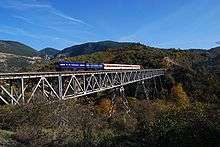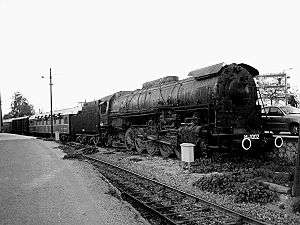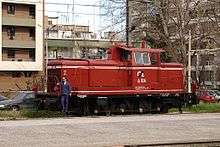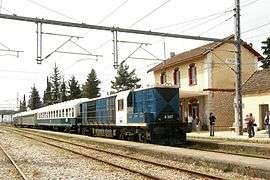Hellenic State Railways
Hellenic State Railways or SEK (Greek: Σιδηρόδρομοι Ελληνικού Κράτους, Sidirodromi Ellinikou Kratous; Σ.Ε.Κ.) was a Greek public sector entity (legal person of public law, Greek: Ν.Π.Δ.Δ.) which was established in 1920 and operated most Greek railway lines until 1970.
History
The Hellenic State Railways took over the standard gauge railway line from Piraeus to Papapouli at the pre-1912 borders, the extension from Papapouli to Platy and most of the former Ottoman railway lines that were within the Greek borders after 1919. These lines were:
- Piraeus, Demerli & Frontiers Railway (Greek: Σιδηρόδρομος Πειραιώς-Δεμερλή-Συνόρων), also known as Larisaikos
- Part of the former Thessaloniki & Monastir Railway (French: Chemin de fer de Salonique à Monastir or SM)
- Part of Chemins de fer Orientaux or CO, between Thessaloniki and Idomeni. The line from Alexandroupolis to Ormenio was transferred to the French-Hellenic Railway Company (Chemin de fer Franco-Hellenique, CFFH) of Evros (Greek: Γαλλοελληνική Εταιρεία Σιδηροδρόμων or ΓΕΣ) which was absorbed by SEK much later, in 1954
- The section of Thessaloniki-Constantinople Railway (French: Jonction Salonique-Constantinople or JSC) between Thessaloniki and Alexandroupolis.
- The 66 km long Sarakli-Stavros line, a former military line (600 mm (1 ft 11 5⁄8 in) gauge) constructed during World War I.
- The 50 km long Skydra local railway, a former military line (600 mm gauge) constructed during World War I and initially operated until 1936 by a company called Local Railways of Macedonia (Greek: Τοπικοί Σιδηρόδρομοι Μακεδονίας).
After World War II the Hellenic State Railways absorbed most other Greek railways, including:
- Piraeus, Athens and Peloponnese Railways (1962), which had already absorbed other minor metre gauge railways.
- Thessaly Railways (1955), including Pelion railway.
- The French-Hellenic Railway Company (Chemin de fer Franco-Hellenique) of Evros (1954).
Only Ellinikoi Ilektrikoi Sidirodromoi (E.I.S., later Athens-Piraeus Electric Railways), operator of Piraeus-Kifissia railway and Piraeus-Perama light railway, and the private mining and industrial lines remained independent.
The Hellenic State Railways existed until December 31, 1970. On the next day all railways in Greece with the exception of private industrial lines and E.I.S. were transferred to Hellenic Railways Organisation S.A., a state-owned corporation.
Network and other infrastructure

During this period very little expansion of the existing network took place, the most notable being:
- The Amyntaio-Kozani branch (1955).
- The 15 km long line from Strymon to Kulata (1966), connecting the Greek and Bulgarian railway networks.
- Another 25 km long branch line from Nea Zichni (Mirini) to Amphipolis (1931), which was later abandoned and the track was lifted in 1970.
- Conversion of the line between Athens and Inoi to double track.
A contract was signed in 1928 for a new line connecting Kalampaka to Kozani, but the project was abandoned in 1932 due to lack of funds.
The Greek railway system (both infrastructure and rolling stock) suffered serious damages during World War II (especially in 1943-1944) and did not become fully operational until 1950. However the viaduct of Achladokampos in Peloponnese, destroyed in 1944, was rebuilt only in 1974.
In 1960 the line from Larissa to Volos, of the former Thessaly Railways, was converted to standard gauge and was connected in Larissa with the line from Athens to Thessaloniki.
New station buildings were constructed in Thessaloniki (known as Thessaloniki New Passenger Station or ΝΕΣΘ) (1952), Larissa (1962), Lianokladi (1950), Sindos, Aiginio, Platamon, Florina, Edessa, Agras, Arnissa, Polykastron, Ptolemais and Kozani.
Rolling stock
Until 1962 the Hellenic State Railways used a variety of steam locomotives from various sources. Some of them belonged to the pre-1920 networks, a number were acquired as part of foreign aid programs after the war and a small number was procured.
Conversion to diesel traction began in the early 1960s. The first diesel locomotives were delivered in 1962 and included 30 Krupp Y60 shunters (Class A-101), 10 ALCo DL532B (Class A-201) and 10 ALCo DL500C (Class A-301). They were followed by classes A-221, A-321, A-351, A-401 and A-411 for the 1,435 mm (4 ft 8 1⁄2 in) standard gauge network and classes A-9101, A-9201 and A-9401 for the 1,000 mm (3 ft 3 3⁄8 in) metre gauge networks.
Diesel multiple units were first introduced in 1936 and became more common in the 1950s and 1960s. Steam locomotives were slowly phased out but were still in limited use in December 1970.
Steam locomotives
The following table shows steam locomotives acquired by the Hellenic State Railways between 1920 and 1969. They also continued to use an assortment of older types of locomotives inherited from the previous Greek and Ottoman railway companies.[1][2][3]
| Photo | Class | Numbers | Type | Quantity | Manufacturer | Serial Nos. | Year | Power | Notes |
|---|---|---|---|---|---|---|---|---|---|
| Αα | 1–4 | 0-4-0T | 4 | Ex CO 403–408 | |||||
| Βα | 11–? | 2-4-0T | Ex CO 321–328 series | ||||||
| Γα | 21–22 | 4-4-0T | 2 | Neilson & Co. | 1892 | Ex SEK 301–302, originally SAP | |||
| Γβ | 31–34 | 4-4-0 | 4 | Ex CO | |||||
| Δα (1st) |
51 | 0-6-0ST | 1 | Manning Wardle | 1892 | Ex SAP | |||
 |
Δα (2nd) |
51–70 | 0-6-0T | 20 | Davenport Locomotive Works, Vulcan Iron Works, H.K. Porter, Inc. |
1945–1946 | 730 hp (544 kW) | USATC S100; several rebuilt as 0-6-0 | |
| Δβ | 61-? | 0-6-0 | Ex Railway Operating Division | ||||||
| Δγ | 71-75 | 0-6-0 | 5 | Ex JSC 50–54 | |||||
 |
Δγ | 76 | 4-4-0 | 1 | StEG | 1888 | Ex CFFH 102, previously CO | ||
| Δδ | 81–87 | 0-6-0 | 7 | Ex CO 4–10 | |||||
| Δε | 88–103 | 0-6-0 | Ex CO 11–54 series | ||||||
| Δζ | 111–114 | 0-6-0 | 4 | Ex CO 502–506 | |||||
| Εα | 201–223 | 2-6-0T | 23 | Batignolles (13) St. Léonard (10) |
1903–1907 | Ex SEK 101–123 | |||
| Εβ | 231–232 | 2-6-0 | 2 | Ex CO 509–510 | |||||
| Εγ | 241–243 | 2-6-0 | 3 | Ex CO 521–523 | |||||
| Ζα | 301–307 | 4-6-0 | 7 | Batignolles | 1906 | Ex SEK 201–207; four-cylinder de Glenn compounds, based on Midi 1400 class | |||
| Ζβ | 311 | 4-6-0 | 1 | Ex SEK 221 | |||||
| Ζγ | 321–330 | 4-6-0 | 10 | Ex JSC 101–110 | |||||
| Ζδ | 341–350 | 4-6-0 | 10 | Ex Prussian P 8 | |||||
| Ζε | 331–333 | 2-6-2 | 3 | Ex CFFH | |||||
| Ηα | 401 | 0-8-0 | 1 | Ex JSC, originally Prussian G 7 | |||||
| Ηβ | 411–423 | 0-8-0 | 13 | Ex JSC 1–16 | |||||
| Ηγ | 431–432 | 0-8-0 | 2 | Ex SBB 4105, 4112 | |||||
| Ηδ | 441–443 | 0-8-0 | 3 | Ex SBB 4130, 4134, 4135 | |||||
| Ηε | 444–446 | 2-8-0 | 3 | Batignolles | 1924 | 903 hp (673 kW) | Ex CFFH, previously CO 260–262 | ||
| Θα | 501 | 2-8-0 | 1 | ex SEK 601 | |||||
| Θβ | 511–512 | 2-8-0 | 2 | Ex SEK 621–622 | |||||
| Θγ | 521–537 551–560 571–595 |
2-8-0 | 27+25 | Baldwin Locomotive Works, American Locomotive Works, Lima Locomotive Works | 1947 | 1,200 hp (895 kW) | USATC S160 521–537 coal-fired, 551–560 oil-fired, 571–595 from Italy in 1959 (FS Class 736) | ||
| Ια | 701–720 | 2-8-2 | 20 | American Locomotive Company | 1915 | ex SEK 401–420 | |||
| Κα | 801–802 | 0-10-0 | 2 | ex SEK 521–522 | |||||
| Κβ | 811–860 | 0-10-0 | 60 | StEG | 1922–1926 | 895 kW (1,200 hp) | kkStB / BBÖ class 80.900 (ÖBB class 57) | ||
| Κβ | 809 | 0-10-0 | 1 | 895 kW (1,200 hp) | kkStB / BBÖ class 80.900 (ÖBB class 57); Ex CFFH | ||||
 |
Κγ | 861–880 | 0-10-0 | 20 | Ateliers de Tubize, Haine St Pierre, St. Léonard La Meuse |
1929 | 895 kW (1,200 hp) | ||
| Κδ | 881–891 | 0-10-0 | 11 | Henschel | Ex Deutsche Reichsbahn 57.10-35 (Prussian G 10), used by the German occupation forces and left behind when they retreated in 1944 | ||||
| Λα | 901–940 | 2-10-0 | 40 | StEG (10), Škoda Works (30) |
1925–1927 | 1,156 kW (1,550 hp) | Südbahn class 580 | ||
| Λβ | 951–966 | 2-10-0 | 16 | North British Locomotive Company | 1946 | 1,141 kW (1,530 hp) | WD Austerity 2-10-0 | ||
| Λγ | 991–998 | 2-10-0 | 8 | Baldwin Locomotive Works | 1947 | 1,270 kW (1,703 hp) | |||
 |
Μα | 1001–1020 | 2-10-2 | 20 | Ansaldo (10) Breda (10) |
1953–1954 | 2,180 kW (2,920 hp) | ||
Diesel locomotives (standard gauge)
| Photo | Class | Numbers | Type | Quantity | Manufacturer | Year | Model | Power | Notes |
|---|---|---|---|---|---|---|---|---|---|
 |
A-101 | 0-6-0 dh | 30 | Krupp | 1962–1967 | Y60 | 478 kW (641 hp) | ||
 |
A-201 | Bo-Bo de | 10 | ALCo | 1962 | DL532B | 772 kW (1,035 hp) | ||
| A-301 | Co-Co de | 10 | ALCo | 1962 | DL500C | 1,470 kW (1,971 hp) | |||
 |
A-321 | Co-Co de | 7 | ALCo | 1967 | DL543 | 1,470 kW (1,971 hp) | ||
 |
A-351 | Co-Co de | 26 | Alsthom | 1967 | CC AD 2100C1 | 1,544 kW (2,071 hp) | ||
| A-401 | Co-Co de | 10 | Siemens-Jung | 1966 | 1,470 kW (1,971 hp) | ||||
 |
A-411 | B-B dh | 20 | Krauss-Maffei | 1963 | V200 | 1,618 kW (2,170 hp) | ||
Diesel locomotives (metre gauge)
| Photo | Class | Numbers | Type | Quantity | Manufacturer | Year | Model | Power | Notes |
|---|---|---|---|---|---|---|---|---|---|
| |
A-9101 | Co-Co de | 12 | ALCo | 1965 | DL537 | 993 kW (1,332 hp) | ||
 |
A-9201 | Co-Co de | 10 | Alsthom | 1967 | CC AD 1600A1 | 1,175 kW (1,576 hp) | ||
 |
A-9401 | B-B dh | 20 | Mitsubishi | 1967 | 48-BB-HI | 478 kW (641 hp) | ||
Diesel multiple units
The Hellenic State Railways bought their first DMUs in 1936 and acquired larger numbers in the 1950s. Additional metre gauge multiple units were ihnerited from networks absorbed in SEK.
| Photo | Class | Numbers | Type | Quantity | Manufacturer | Year | Model | Power | Notes |
|---|---|---|---|---|---|---|---|---|---|
| (AA11) | 2-Bo de | 2 | Floridsdorf | 1936 | |||||
| AA11-AA26 A111-A118 |
A1-1A+2-2 | 16 | FIAT | 1950 | |||||
 |
AA27-AA36 A119-A128 |
A1-1A+2-2 | 10 | FIAT | 1958 | ||||
| AA41 | 2-B | 9 | Renault | 1950 | |||||
| AA61 | B-B | 3 | MAN | 1955 | |||||
 |
AA71 | 2-B | 20 | Ferrostaal-Esslingen | 1962 | ||||
See also
References and notes
- ↑ J.D.H. Smith (2005–2007). "HSR steam locomotives". Retrieved 2008-06-09.
- ↑ Zartaloudis et al. 1997, pp. 172–173.
- ↑ Durrant 1972, pp. 51–54.
- Durrant, A. E. (1972) [1966]. The Steam Locomotives of Eastern Europe. Newton Abbot, Devon, UK: David and Charles. pp. 50–60. ISBN 0-7153-4077-8.
- Smith, J. D. H. (2005–2007). "HSR steam locomotives". Retrieved 2008-06-09.
- Zartaloudis, I.; Karatolos, D.; Koutelidis, D.; Nathenas, G.; Fasoulas, S.; Filippoupolitis, A. (1997). Οι Ελληνικοί Σιδηρόδρομοι (Hellenic Railways) (in Greek). Μίλητος (Militos). ISBN 960-8460-07-7. It is the only extensive and authoritative source for the history of Greek railways.
Further reading
- W. F., Simms (1997). The railways of Greece. Wilfried F. Sims. ISBN 0-9528881-1-4. Contains brief history, simple line maps and extensive list of rolling stock until 1997.
- Organ, J. (2006). Greece Narrow Gauge. Middleton Press. ISBN 1-904474-72-1.
- Voyageur (Anonymous) (February 1941). "The Railways of Greece". The Railway Magazine. London, UK: Railway Publications. 87 (524): 64.
- D. W., Winkworth (May 1967). "Peloponnese Narrow Gauge". The Railway Magazine. London, UK: Transport & Technical Publications Ltd. 113 (793): 249–254.
- "Railway systems in Greece". Cheltenham, UK: The Restoration & Archiving Trust. 2007. Retrieved 2008-05-21.
